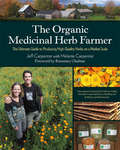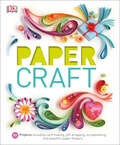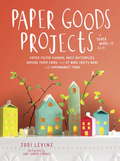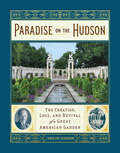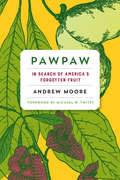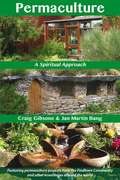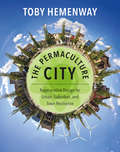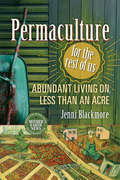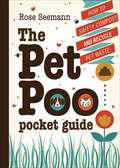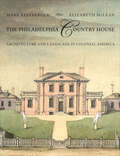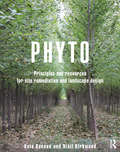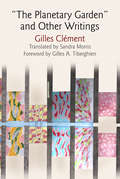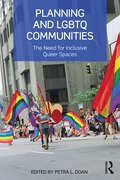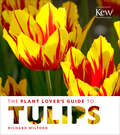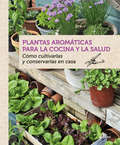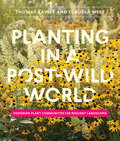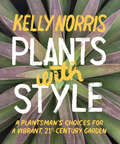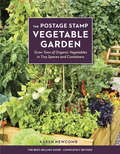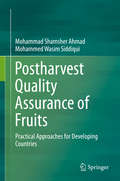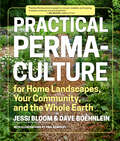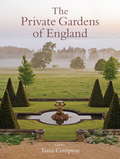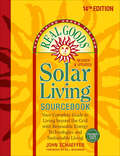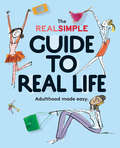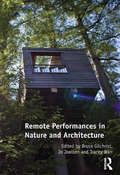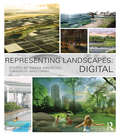- Table View
- List View
The Organic Medicinal Herb Farmer: The Ultimate Guide to Producing High-Quality Herbs on a Market Scale
by Melanie Carpenter Jeff Carpenter Rosemary GladstarA new approach to growing local medicine, including information on geo-authenticity, wildcrafting, and developing a good business plan Both a business guide and a farming manual, The Organic Medicinal Herb Farmer will teach readers how to successfully grow and market organic medicinal Western herbs. Whether you're trying to farm medicinal plants, culinary herbs, or at-risk native herbs exclusively or simply add herbal crops to what you're already growing, successful small-scale herb farmers Jeff and Melanie Carpenter will guide you through the entire process--from cultivation to creating value-added products. Using their Zack Woods Herb Farm in Vermont as a backdrop, the Carpenters cover all the basic practical information farmers need to know to get an organic herb farm up and running, including: * Size and scale considerations; * Layout and design of the farm and facilities; * Growing and cultivation information, including types of tools; * Field and bed prep; * Plant propagation; * Weed control, and pests and diseases; * Harvesting, as well as wild harvesting and the concept of geo-authentic botanicals; * Postharvest processing; and, * Value-added products and marketing. The authors also provide fifty detailed plant profiles, going deeper into the herbs every farmer should consider growing. In an easy-to-understand, practical, and comprehensive manner, readers will learn how to focus on quality over quantity, and keep costs down by innovating with existing equipment, rather than expensive technology.Market farmers who have never before considered growing medicinal herbs will learn why it's more important to produce these herbs domestically. The Organic Medicinal Herb Farmer makes a convincing case that producing organic medicinal herbs can be a viable, profitable, farming enterprise. The Carpenters also make the case for incorporating medicinal herbs into existing operations, as it can help increase revenue in the form of value-added products, not to mention improve the ecological health of farmland by encouraging biodiversity as a path toward greater soil health.
Paper Craft: 50 Projects Including Card Making, Gift Wrapping, Scrapbooking, and Beautiful Pa
by DKPaper Craft makes it easy — and affordable — to design handmade crafts that are guaranteed to impress. Transform your favorite paper into beautiful decorations and home decor, greeting cards, scrapbooks, and beyond, no matter what your skill level.This visual, step-by-step guide outlines all the necessary equipment and materials and contains nifty techniques like scaling, embossing, and crumpling, as well as quilling, decoupage, and paper-mâché. Inside Paper Craft you'll find seasonal and special occasion paper craft ideas to suit a variety of tastes. And, templates and variation suggestions allow you to choose exactly the right look for your projects.Cut, fold, roll, glue, and print your way to crafting heaven with Paper Craft.
Paper Goods Projects
by Jodi Levine Amy Gropp ForbesCraft to your heart's content without making a trip to a specialty store. Once you've glimpsed the inspired creations in Paper Goods Projects, you'll never look at your pantry shelves or recycling bins the same way. Here are 60 fun and simple crafts that transform everyday items: paper towel tubes turn into safari animals, coffee filters dyed bright colors bloom into water lilies, doilies make a charming crown, and cereal boxes become the building blocks of a mini city. Paper Goods Projects has crafts for birthday party favors and decorations, cake toppers, greeting cards, children's toys, and so much more. Tap your creativity like never before to create fun, beautiful objects out of the simplest materials.
Paradise on the Hudson: The Creation, Loss, and Revival of a Great American Garden
by Caroline Seebohm&“Through her prodigious research and evocative prose, Caroline Seebohm recreates an era of New York life seen through the history and dazzling beauty of the restored Untermyer Gardens.&” —Paula Deitz, author, Of Gardens On a single day in 1939, more than 30,000 people visited the Untermyer Garden—at the time, one of the world&’s grandest landscapes. Thirty years later, most of the site had been sold or abandoned. Who was the eccentric visionary behind the estate&’s original glory? What triggered the garden&’s decline and sparked its restoration? In Paradise on the Hudson, Caroline Seebohm brings to light the remarkable story of a larger-than-life figure lost mostly to history, and the impact of his horticultural obsession. It is a fascinating tale about of the role of passion in both creating and rescuing one of America&’s greatest gardening achievements.
Pawpaw
by Andrew Moore Michael W. TwittyThe largest edible fruit native to the United States tastes like a cross between a banana and a mango. It grows wild in twenty-six states, gracing Eastern forests each fall with sweet-smelling, tropical-flavored abundance. Historically, it fed and sustained Native Americans and European explorers, presidents, and enslaved African Americans, inspiring folk songs, poetry, and scores of place names from Georgia to Illinois. Its trees are an organic grower's dream, requiring no pesticides or herbicides to thrive, and containing compounds that are among the most potent anticancer agents yet discovered. So why have so few people heard of the pawpaw, much less tasted one? In Pawpaw, author Andrew Moore explores the past, present, and future of this unique fruit, traveling from the Ozarks to Monticello; canoeing the lower Mississippi in search of wild fruit; drinking pawpaw beer in Durham, North Carolina; tracking down lost cultivars in Appalachian hollers; and helping out during harvest season in a Maryland orchard. Along the way, he gathers pawpaw lore and knowledge not only from the plant breeders and horticulturists working to bring pawpaws into the mainstream (including Neal Peterson, known in pawpaw circles as the fruit's own "Johnny Pawpawseed"), but also regular folks who remember eating them in the woods as kids, but haven't had one in over fifty years. As much as Pawpaw is a compendium of pawpaw knowledge, it also plumbs deeper questions about American foodways--how economic, biologic, and cultural forces combine, leading us to eat what we eat, and sometimes to ignore the incredible, delicious food growing all around us. If you haven't yet eaten a pawpaw, this book won't let you rest until you do.
Permaculture: A Spiritual Approach
by Craig Gibsone Jan Martin BangPermaculture design as divine creative activity. Permaculture looks for the patterns embedded in our natural world as inspirations for designing solutions to the many challenges we are presented with today. It is a philosophical, spiritual and practical approach to the use of the land, integrating microclimate, functional plants, animals, soils, water management and human needs into intricately connected, highly productive systems. In essence, permaculture uses observation as basis for creating sustainable and effective human settlements. The authors discuss the components Earthshare, Fairshare and Peoplecare, with a specific emphasis on the spiritual aspects of the design process. Topics range from soil and plants, energy sources and house design to alternative economics, group process, governance, and spiritual nurturing and enquiry. Examples of existing permaculture structures from around the world, most notably from the Findhorn Community Eco-Village, bring the concepts to life. First-hand accounts of how people got started on their permaculture project lend a personal touch. The first book to look at the spiritual aspects as well as the practical implementation of permaculture design.
The Permaculture City
by Toby HemenwayPermaculture is more than just the latest buzzword; it offers positive solutions for many of the environmental and social challenges confronting us. And nowhere are those remedies more needed and desired than in our cities. The Permaculture City provides a new way of thinking about urban living, with practical examples for creating abundant food, energy security, close-knit communities, local and meaningful livelihoods, and sustainable policies in our cities and towns. The same nature-based approach that works so beautifully for growing food--connecting the pieces of the landscape together in harmonious ways--applies perfectly to many of our other needs. Toby Hemenway, one of the leading practitioners and teachers of permaculture design, illuminates a new way forward through examples of edge-pushing innovations, along with a deeply holistic conceptual framework for our cities, towns, and suburbs. The Permaculture City begins in the garden but takes what we have learned there and applies it to a much broader range of human experience; we're not just gardening plants but people, neighborhoods, and even cultures. Hemenway lays out how permaculture design can help towndwellers solve the challenges of meeting our needs for food, water, shelter, energy, community, and livelihood in sustainable, resilient ways. Readers will find new information on designing the urban home garden and strategies for gardening in community, rethinking our water and energy systems, learning the difference between a "job" and a "livelihood," and the importance of placemaking and an empowered community. This important book documents the rise of a new sophistication, depth, and diversity in the approaches and thinking of permaculture designers and practitioners. Understanding nature can do more than improve how we grow, make, or consume things; it can also teach us how to cooperate, make decisions, and arrive at good solutions.
Permaculture for the Rest of Us
by Jenni BlackmoreMany of us want to increase our self-sufficiency, but few have access to the ideal five sunny, gently sloping acres of rich, loamy, well-drained soil. Jenni Blackmore presents a highly entertaining, personal account of how permaculture can be practiced in adverse conditions, allowing anyone to learn to live more sustainably in a less-than-perfect world. With a rallying cry of "If we can do it, you can too," she distills the wisdom of twenty years of trial and error into a valuable teaching tool.The perfect antidote to dense, high-level technical manuals, Permaculture for the Rest of Us presents the fundamental principles of this sometimes confusing concept in a humorous, reader-friendly way. Each chapter focuses on a specific method or technique, interspersing straightforward explanations with the author's own experiences. Learn how to successfully retrofit even the smallest homestead using skills such as: No-till vs. till gardening, composting, and soil-building Natural pest control and integrating small livestock Basic greenhouse construction Harvesting, preservation, and moreIdeal for urban dreamers, suburbanites and country-dwellers alike, this inspirational and instructional "encouragement manual" is packed with vibrant photographs documenting the author's journey from adversity to abundance. Jenni Blackmore is a farmer, artist, writer and certified Permaculture Design Consultant who built her house on a rocky, windswept island off the coast of Nova Scotia almost twenty-five years ago and has been stumbling along the road to self-sufficient living ever since. A successful micro-farmer, she produces most of her family's meat, eggs, fruit, and vegetables, in spite of often-challenging conditions.
The Pet Poo Pocket Guide: How to Safely Compost and Recycle Pet Waste
by Rose SeemannEighty-three million dogs and ninety-six million cats call the United States home. Dogs alone produce enough waste to fill more than 1,091 football fields 1 foot deep in a single year. Add billions of plastic pick-up bags to the mix and season well with tons of litter box waste. Scoop a hefty portion into local landfills and seal it tightly to ensure optimal methane production. Clearly, this is a recipe for disaster.Dog and cat owners who trash their pets' offerings daily are in denial about how much waste is produced and what happens to it. Those who want to make the responsible choice often turn to the internet, only to find misleading, confusing, and contradictory information. The Pet Poo Pocket Guide will help you reduce your pet's environmental paw print with: Best practices for cycling pet waste back to nature Suggestions on how to tailor your approach based on location, situation, weather, needs, or available time Instructions for using your composted pet waste safely to enrich your soil and nourish ornamental plantsWith recycling tactics clearly indicated as "easy," "moderate," or "demanding," The Pet Poo Pocket Guide offers something for everyone. This no-nonsense guide is a must-read for any pet owner who is concerned about the environmental impact of their best friend, and is seeking a safe and practical solution.Rose Seemann is the owner and operator of EnviroWagg, a company dedicated to collecting and composting canine waste into safe, nutrient-rich garden soil.
The Philadelphia Country House: Architecture and Landscape in Colonial America
by Mark E. Reinberger Elizabeth McLeanA highly readable, beautifully illustrated study of the homes built by elite colonial Philadelphians as retreats—which balanced English models with developing local taste.Colonial Americans, if they could afford it, liked to emulate the fashions of London and the style and manners of English country society while at the same time thinking of themselves as distinctly American. The houses they built reflected this ongoing cultural tension. By the mid-eighteenth century, Americans had developed their own version of the bourgeois English countryseat, a class of estate equally distinct in social function and form from townhouses, rural plantations, and farms. The metropolis of Philadelphia was surrounded by a particularly extraordinary collection of country houses and landscapes. Taken together, these estates make up one of the most significant groups of homes in colonial America.In this masterly volume, Mark Reinberger, a senior architectural historian, and Elizabeth McLean, an accomplished scholar of landscape history, examine the country houses that the urban gentry built on the outskirts of Philadelphia in response to both local and international economic forces, social imperatives, and fashion. What do these structures and their gardens say about the taste of the people who conceived and executed them? How did their evolving forms demonstrate the persistence of European templates while embodying the spirit of American adaptation?The Philadelphia Country House explores the myriad ways in which these estates—which were located in the country but responded to the ideas and manners of the city—straddled the cultural divide between urban and rural. Moving from general trends and building principles to architectural interiors and landscape design, Reinberger and McLean take readers on an intimate tour of the fine, fashionable elements found in upstairs parlors and formal gardens. They also reveal the intricate working world of servants, cellars, and kitchen gardens. Highlighting an important aspect of American historic architecture, this handsome volume is illustrated with nearly 150 photographs, more than 60 line drawings, and two color galleries.
Phyto: Principles and Resources for Site Remediation and Landscape Design
by Kate Kennen Niall KirkwoodWinner of the 2017 CBHL Literature Award of Excellence in Landscape Design and Architecture Phyto presents the concepts of phytoremediation and phytotechnology in one comprehensive guide, illustrating when plants can be considered for the uptake, removal or mitigation of on-site pollutants. Current scientific case studies are covered, highlighting the advantages and limitations of plant-based cleanup. Typical contaminant groups found in the built environment are explained, and plant lists for mitigation of specific contaminants are included where applicable. This is the first book to address the benefits of phytotechnologies from a design point of view, taking complex scientific terms and translating the research into an easy-to-understand reference book for those involved in creating planting solutions. Typically, phytotechnology planting techniques are currently employed post-site contamination to help clean up already contaminated soil by taking advantage of the positive effects that plants can have upon harmful toxins and chemicals. This book presents a new concept to create projective planting designs with preventative phytotechnology abilities, ‘phytobuffering’ where future pollution may be expected for particular site programs. Filled with tables, photographs and detailed drawings, Kennen and Kirkwood's text guides the reader through the process of selecting plants for their aesthetic and environmental qualities, combined with their contaminant-removal benefits.
"The Planetary Garden" and Other Writings (Penn Studies in Landscape Architecture)
by Gilles ClémentCelebrated landscape architect Gilles Clément may be best known for his public parks in Paris, including the Parc André Citroën and the garden of the Musée du Quai Branly, but he describes himself as a gardener. To care for and cultivate a plot of land, a capable gardener must observe in order to act and work with, rather than against, the natural ecosystem of the garden. In this sense, he suggests, we should think of the entire planet as a garden, and ourselves as its keepers, responsible for the care of its complexity and diversity of life."The Planetary Garden" is an environmental manifesto that outlines Clément's interpretation of the laws that govern the natural world and the principles that should guide our stewardship of the global garden of Earth. These are among the tenets of a humanist ecology, which posits that the natural world and humankind cannot be understood as separate from one another. This philosophy forms a thread that is woven through the accompanying essays of this volume: "Life, Constantly Inventive: Reflections of a Humanist Ecologist" and "The Wisdom of the Gardener." Brought together and translated into English for the first time, these three texts make a powerful statement about the nature of the world and humanity's place within it.
Planning and LGBTQ Communities: The Need for Inclusive Queer Spaces
by Petra L. DoanAlthough the last decade has seen steady progress towards wider acceptance of lesbian, gay, bisexual, transgendered, and queer (LGBTQ) individuals, LGBTQ residential and commercial areas have come under increasing pressure from gentrification and redevelopment initiatives. As a result many of these neighborhoods are losing their special character as safe havens for sexual and gender minorities. Urban planners and municipal officials have sometimes ignored the transformation of these neighborhoods and at other times been complicit in these changes. Planning and LGBTQ Communities brings together experienced planners, administrators, and researchers in the fields of planning and geography to reflect on the evolution of urban neighborhoods in which LGBTQ populations live, work, and play. The authors examine a variety of LGBTQ residential and commercial areas to highlight policy and planning links to the development of these neighborhoods. Each chapter explores a particular urban context and asks how the field of planning has enabled, facilitated, and/or neglected the specialized and diverse needs of the LGBTQ population. A central theme of this book is that urban planners need to think "beyond queer space" because LGBTQ populations are more diverse and dispersed than the white gay male populations that created many of the most visible gayborhoods. The authors provide practical guidance for cities and citizens seeking to strengthen neighborhoods that have an explicit LGBTQ focus as well as other areas that are LGBTQ-friendly. They also encourage broader awareness of the needs of this marginalized population and the need to establish more formal linkages between municipal government and a range of LGBTQ groups. Planning and LGBTQ Communities also adds useful material for graduate level courses in planning theory, urban and regional theory, planning for multicultural cities, urban geography, and geographies of gender and sexuality.
The Plant Lover's Guide to Tulips (The Plant Lover’s Guides)
by Richard WilfordTulips are one of the most popular spring-flowering bulbs. Available in a huge range of colors and in a wide array of shapes, they’re a mainstay of most spring gardens. They are the focus of festivals worldwide and are a sure sign spring is on the way. The Plant Lover’s Guide to Tulips, by Richard Wilford of the Royal Botanic Gardens Kew, profiles 100 commonly available species and cultivars, and features growing information, recommendations for companion plants, and tips on how to use tulips in the landscape. More than 250 color photographs bring these colorful gems to life.
Plantas aromáticas para la cocina y la salud: Cómo cultivarlas y conservarlas en casa
by Bénédicte BoudassouAprende a cultivar las plantas aromáticas y cómo conservarlas en casa Las plantas aromáticas siempre han sido las mejores aliadas para transformar nuestros platos. Nos ayudan a evocar los sabores de antes y a descubrir otros nuevos, además de ofrecer un sinfín de beneficios para nuestra salud y bienestar en el día a día. Para disfrutar de las plantas aromáticas y su cultivo, solamente hay que seguir los consejos de esta guía, que nos permite: o Conocer con detalle las plantas aromáticas y sus particularidades.o Aprender las mejores técnicas para su cultivo, recolección y conserva.o Consultar 40 fichas ilustradas con consejos para su uso y consumo, información sobre sus propiedades saludables y mucho más.
Planting in a Post-Wild World: Designing Plant Communities for Resilient Landscapes
by Thomas Rainer Claudia West“As practical as it is poetic. . . . an optimistic call to action.” —Chicago Tribune Over time, with industrialization and urban sprawl, we have driven nature out of our neighborhoods and cities. But we can invite it back by designing landscapes that look and function more like they do in the wild: robust, diverse, and visually harmonious. Planting in a Post-Wild World by Thomas Rainer and Claudia West is an inspiring call to action dedicated to the idea of a new nature—a hybrid of both the wild and the cultivated—that can flourish in our cities and suburbs. This is both a post-wild manifesto and practical guide that describes how to incorporate and layer plants into plant communities to create an environment that is reflective of natural systems and thrives within our built world.
Plants with Style: A Plantsman's Choices for a Vibrant, 21st-Century Garden
by Kelly Norris“A love letter to plants…that oozes enthusiasm.” —The English Garden Why settle for lackluster gardens filled with dull, ho-hum plants? In this spirited, provocative book, plant guru Kelly Norris calls for a garden revolution: out with the boring plants and in with the exciting newcomers that will make your jaw drop and your pulse quicken! A passionate horticulturist and lifelong gardener, Kelly is the ideal guide to the botanical riches available to today’s gardeners. In chapters on environment, structure, seasonal standouts, and plant combinations he shines a spotlight on the A-list plants in every category—plants that will thrive, not merely survive. Along the way, he shows you how to forge a personal style in harmony with your garden’s setting and local environment. As Kelly puts it, “A garden is the best way to savor life on earth.” Let Plants with Style guide you to the plants that will provide a richer, more fulfilling connection between you and your own patch of soil.
The Postage Stamp Vegetable Garden
by Karen NewcombThis classic gardening bestseller (over 500,000 copies sold) uses ecologically friendly, intensive biodynamic methods to produce large amounts of vegetables in very tiny spaces. Revised for an all new generation of gardeners, the 40th anniversary edition includes brand new information on the variety of heirloom vegetables available today and how to grow them the postage stamp way. To accommodate today's lifestyles, a garden needs to fit easily into a very small plot, take as little time as possible to maintain, require a minimum amount of water, and still produce prolifically. That's exactly what a postage stamp garden does. Postage stamp gardens are as little as 4 by 4 feet, and, after the initial soil preparation, they require very little extra work to produce a tremendous amount of vegetables--for instance, a 5-by-5-foot bed will produce a minimum of 200 pounds of vegetables. When first published 40 years ago, the postage stamp techniques, including closely planted beds rather than rows, vines and trailing plants grown vertically to free up space, and intercropping, were groundbreaking. Now, in an ever busier world, the postage stamp intensive gardening method continues to be invaluable for gardeners who wish to weed, water, and work a whole lot less yet produce so much more.From the Trade Paperback edition.
Postharvest Quality Assurance of Fruits
by Mohammad Shamsher Ahmad Mohammed Wasim SiddiquiThis book presents a comprehensive study of the handling of fresh fruits in the developing world from harvesting to the shelf. With annual losses ranging from 30-40% due to lack of knowledge on proper handling practices and value addition, this book's information on postharvest handling and quality testing is crucial for reducing these losses and improving the quality and safety of fresh fruits in these areas. With its added focus on marketing and organized retail aspects, Postharvest Quality Assurance of Fruits: Practical Approaches for Developing Countries covers the entire range of fruit handling, from transportation and packaging to quality assessment and commercial preparation. In presenting a fully comprehensive outline of the factors affecting postharvest quality and marketability of fruits, this work lays the foundation for understanding the proper storage, transportation and packaging methods to prevent losses and increase quality. With its study of prevailing marketing systems, supply chains and retail methods, the book presents the complete picture for the postharvest handling of fruits in the developing world.
Practical Permaculture: for Home Landscapes, Your Community, and the Whole Earth
by Jessi Bloom Dave Boehnlein Mr Paul Kearsley“Practical Permaculture is powerful, visceral, readable, and inspiring. It shows us how we can and should live.” —Joel Salatin, farmer and author Jessi Bloom and Dave Boehnlein, two dynamic leaders in the permaculture community, offer authoritative, in-depth, hands-on advice that shares a holistic approach to sustainable living. Permaculture is a growing trend, but still a daunting concept to many. New to permaculture principles and techniques? The guesswork will be eliminated by paging through this invaluable resource. Already an expert? This guide will surely make an important addition to your sustainable agriculture reference shelf.
The Private Gardens of England
by Tania ComptonThe Sunday Times Gardening Book of the YearDescribed by Vogue as 'the revelatory garden book for our age' and a 'splendid new book' (Sebastian Shakespeare, Daily Mail), The Private Gardens of England is a glorious celebration of the art of gardening through some of the country's hidden horticultural jewels.Thirty-five English private gardens, thoughtfully selected by the writer and designer Tania Compton, are vividly described in the words of their owners, who bring an astonishing sense of intimacy to their own creations as well as their collaborations with some of the leading garden designers of today.From the Bannermans' romantic Cornish castle to the windswept shores of Howick in Northumberland via Jasper Conran in Somerset and Tom Stuart-Smith in Hertfordshire, an eclectic range of gardens is revealed. The traditional English garden is seen through the fresh eyes of plantswomen such as Mary-Anne Robb at Cothay Manor and Arabella Lennox-Boyd at Gresgarth Hall, alongside Hilborough House in Norfolk and Ferne Park in Dorset that recently only existed as fields. The historic landscape gardens of Boughton House and St Paul's Walden Bury are explored alongside the contemporary and conceptual at Plaz Metaxu in Devon. From the private walled garden at Petworth to the wildflower-strewn meadows of Spye Park, each garden is a testament to the thriving art of English gardening.With contributions from the country's best garden photographers, The Private Gardens of England reveals gardening at its highest level. It will inform and inspire anyone with a love of gardening, beauty and excellence.'The photographs are take-your-breath-away spellbinding . . . The minute level of detail here will satisfy real gardeners, elevating this book far above its competition.' Sarah Feeley, English Garden'Captures a brilliant moment in our history, where plantsmanship, good design and love of plants have all come together . . . compelling format . . . the photography and production are superb.' Kathryn Bradley-Hole, Country LifeOne of Christopher Woodward's Books of the Year in the Evening Standard
Real Goods Solar Living Sourcebook (Mother Earth News Books for Wiser Living)
by John SchaefferWhat book would you want if you were stranded on a desert island? Widely regarded as the "bible" of off-grid living, Real Goods Solar Living Source Book might be your best choice. With over six hundred thousand copies in print worldwide, it is the most comprehensive resource available for anyone interested in lessening their environmental footprint or increasing their energy independence.The Solar Living Sourcebook, Fourteenth Edition is the ultimate guide to renewable energy, sustainable living, natural and green building, off-grid living, and alternative transportation, written by experts with decades of experience and a passion for sharing their knowledge. This fully revised and updated edition includes brand new sections on permaculture and urban homesteading and completely rewritten chapters on solar technology, sustainable transportation, and relocalization. It also boasts greatly expanded material on: Natural building Permaculture and biodynamics Electric and biofuel-powered vehicles Passive solar Solar water heating Grid-tie photovoltaic systems--plus maps, wiring diagrams, formulae, charts, electrical code, solar sizing worksheets, and much more.Whether you're a layperson or a professional, novice or longtime aficionado, the Sourcebook puts the latest research and information at your fingertips--everything you need to know to make sustainable living a reality.John Schaeffer is the president and founder of Real Goods--the foremost global source for tools and information on renewable energy, energy efficiency, and sustainable living. Since 1978, through Real Goods, he has pioneered solar technology in North America, providing over one hundred and fifty megawatts of solar power and helping to solarize over eighteen thousand homes.
The Real Simple Guide to Real Life: Adulthood made easy.
by The Editors of Real Simple MagazineREAL SIMPLE, the #1 women's lifestyle magazine, shares the secrets to mastering "life 101"--from home to work to relationships--in this must-have, illustrated handbook to help young adults navigate their busy, new lives. Right after graduation, the questions start piling up. And they just keep on coming throughout your 20s and beyond: How do I find a job that I love--and, um that pays? What should I wear to the interview? And speaking of clothes, where do I put them when my apartment doesn't even have a closet? REAL SIMPLE created The Real Simple Guide to Real Life: Adulthood Made Easy to answer all of those questions--and so many more. Original essays from best-selling young writers and practical advice from expert contributors simplify (and demystify) landing a job, finding an apartment, decorating on the cheap, cooking for one, dressing for work, organizing a small space, picking a mentor, writing a thank-you note (yes, they're still a thing)--plus all the answers you need to deal with 401(k)s, kitchen fails, epic hangovers, messy roommates, and even messier breakups. Hear from these inspiring women and others about what they wish they had known when they were starting out: Gretchen Rubin, Barbara Corcoran, Rosie Schaap, Gail Simmons, Melinda Gates, Cristina Henríquez, Madeleine Albright, Doree Shafrir, Camille Styles, Egypt Sherrod, Kelly Wearstler, Brené Brown, Edan Lepucki, Abby Larson, Emmy Rossum, Jenni Konner, Jessica Alba, Molly Antopol, Anna Holmes, Rachel Sklar, and J. Courtney Sullivan.
Remote Performances in Nature and Architecture
by Bruce Gilchrist Jo JoelsonOutlandia is an off-grid artists’ fieldstation, a treehouse imagined by artists London Fieldworks (Bruce Gilchrist & Jo Joelson) and designed by Malcolm Fraser Architects, situated in Glen Nevis, opposite Ben Nevis. It is performative architecture that immerses its occupants in a particular environment, provoking creative interaction between artists and the land. This book explores the relationship between place and forms of thought and creative activity, relating Outlandia and the artists there to the tradition of generative thinking and making structures that have included Goethe’s Gartenhaus in Weimar, Henry Thoreau's cabin at Walden Pond and Dylan Thomas’s writing shack in Laugharne. Based on a series of residencies and radio broadcasts produced by London Fieldworks in collaboration with Resonance 104.4fm, the Remote Performances project enabled twenty invited artists to consider and engage in transmissions, sound performances and dialogues on their artmaking strategies immersed in this specific rural environment of mountain, forest and river; flora and fauna. Some artists engaged in dialogue with people living and working in the area with a range of specialisms and experience in, for examples, forestry, mountain culture, wildlife, tourism, and local history. This book explores the ways in which being in the field impacts on artists and permeates through to the artworks they create. It considers the relationship between geography and contemporary art and artists’ use of maps and fieldwork. It charts these artists’ explorations of the ecological and cultural value of the natural environment, questioning our perceptions and relationships to landscape, climate and their changes. The book is an inspiring collection of ways to think differently about our relationship with the changing natural environment. The book includes essays by Jo Joelson, Francis McKee, Tracey Warr and Bruce Gilchrist, and texts, images and drawings by the artists: Bram Thomas Arn
Representing Landscapes: Digital
by Nadia AmorosoMost landscape architectural designs now include some form of digital representation - but there is much more scope for creativity beyond the standard Photoshop montages. In this new book on representing landscapes, Nadia Amoroso brings together contributions from some of the leading landscape departments in the world to explore the variety in digital illustration methods. In each chapter, leading lecturers, professors and practitioners in the field of landscape architecture explain a specific digital approach with the use of images from their department to show how each technique can be used in inspirational examples. Throughout the book over 200 colour images cover the spectrum of digital representation to help discuss the various drawing types which are invaluable when communicating ideas in the field of landscape architecture. With worked examples in the chapters and downloadable images suitable for class use, this is an essential book for visual communication and design studios.
